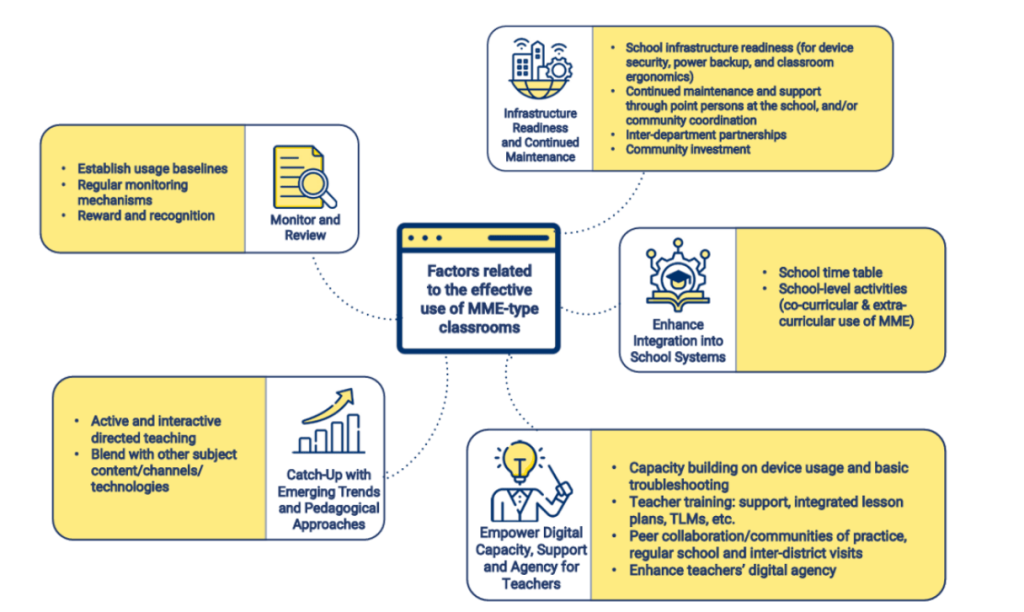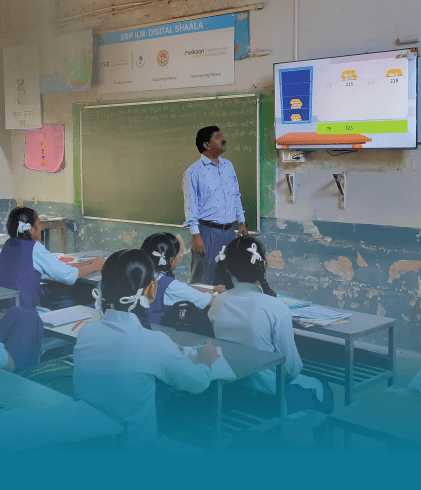On a recent visit to a government school in Gwalior, Madhya Pradesh, we (CSF team) stepped into a classroom proudly labeled as a ‘Smart Classroom’. Mounted on the wall was a Smart TV— technology meant to revolutionise learning. But as we watched, the teacher reluctantly used the remote, struggling to navigate the digital content. After playing a video for 7–8 minutes, he returned to the blackboard, continuing the lesson as if the smart classroom didn’t exist.
This scenario is far from uncommon. Across India, thousands of schools have smart TVs, projectors and Interactive Flat Panel Devices (IFPDs) installed through various funding schemes. Yet, much of this expensive infrastructure remains underutilised.
Smart Classrooms in India: Infrastructure Without Implementation
For over 15 years, smart classrooms have been introduced across India through initiatives like Samagra Shiksha Abhiyan, CSR-funded programs, multilateral agency projects, and school transformation efforts.
In FY 2024–25, the Department of School Education and Literacy received ₹73,008 crore, with ₹37,010 crore allocated to Samagra Shiksha. Of the ₹4,700 crore earmarked for school technology, over ₹1,900 crore—about 5% of the Samagra budget and 40% of the ICT (information and communication technology) budget—was dedicated to smart classrooms.
Despite this sustained investment, many schools still struggle to use the technology effectively. Understanding the barriers to meaningful adoption can help education funders, including central and state governments, develop stronger policies, budgets, and implementation protocols. In line with this, Central Square Foundation (CSF) partnered with the Center of Excellence in Teacher Education (CETE) at Tata Institute of Social Sciences (TISS) and Muskaan Dreams, a nonprofit working on improving digital access in government classrooms, to study smart classroom use across government schools in Madhya Pradesh.
Unpacking the Research – Studying Engagement with Digital Classrooms in Upper Primary and Secondary Government Schools in Madhya Pradesh
- Objective
India is rapidly expanding smart classrooms in government schools, yet their actual usage remains largely undocumented. While technology is assumed to enhance learning, evidence on teacher adoption, student engagement, and implementation barriers is limited. To explore this, TISS and CSF studied digital classrooms in two Madhya Pradesh districts, where Muskaan Dreams ran the Digital Shaala programme using CSF’s TicTacLearn content—engaging videos aligned with national and state curricula. The research examined teacher preparedness, infrastructure gaps, content usage, and student interaction to identify what drives or hinders successful smart classroom adoption. These insights aim to guide future policy and improve implementation.
- Key Research Questions and Methodology
This study aims to answer four broad questions:
- What value do teachers and students ascribe to smart classroom technology?
- How are smart classrooms used in government schools?
- What are the motivators and obstacles in adopting a smart classroom?
- How sustainable is a smart classroom in the absence of ongoing programme support?
Through school visits, classroom observations, teacher interviews, student focus group discussions and backend usage data analysis, the study identified gaps in digital integration and provided actionable recommendations for policymakers, education administrators and EdTech developers.
(c) Key Findings
- Infrastructure
One of the biggest barriers to sustained smart classroom use is infrastructure upkeep. The study found that frequent power outages, lack of device security, broken devices and missing maintenance support led to 50% of smart classrooms becoming non-functional within two years of setup. Schools that collaborated with local government bodies and village councils to address power and security challenges saw higher adoption. Involving School Management Committees (SMCs) fostered ownership and improved maintenance.
- Teacher Training and Digital Confidence
In schools where smart classrooms thrived, teachers were trained not just in operating the devices, but in integrating technology into their teaching methods. However, when training was limited to one-time technical demos—often too technical or brief—teachers reverted to traditional chalk-and-talk methods, viewing smart classrooms as an optional add-on rather than an integral teaching tool.
Teachers reported that they had little autonomy over content selection, with no regular training being provided to support smart classroom engagement. Older and more experienced teachers faced more difficulty with digital adoption, compared to younger teachers who were already comfortable with technology. Additionally, hands-on classroom-based training proved more effective than theoretical workshops. Regular peer-learning sessions, teacher networks and mentoring can boost digital confidence.
- Integration into School Ecosystem
For smart classrooms to be effective, they must be integrated into school routines. The study found that aligning digital learning with timetables ensures regular use of the smart classroom, boosting adoption. Schools using smart classrooms for co-curricular activities saw higher engagement. Clear guidelines and flexible, subject-specific interventions can enhance integration, fostering greater teacher and student ownership of technology.
- Monitoring and Feedback
Without regular monitoring, smart classrooms often went into unuse. The study found that schools with structured review mechanisms had higher sustained usage, yet the absence of a dashboard-based tracking system remained a challenge.
Recognition and incentives play a key role in technology integration. When teachers and schools received acknowledgment for innovative digital practices, they were more likely to integrate technology effectively. In contrast, the absence of usage reviews led to technology stagnation.
Schools should adopt data-driven monitoring tools to track usage and impact, coupled with periodic teacher feedback loops. Additionally, reward mechanisms such as certificates, school rankings, or peer recognition can help sustain long-term engagement.
- Content
Content relevance and pedagogical alignment are key to smart classroom success. Interactive, gamified content is preferred. Some schools used YouTube/DIKSHA, while others lacked fresh content. Schools allowing teachers to choose content saw higher engagement. Localized, interactive, curriculum-aligned content in regional languages improved effectiveness.
The Road Ahead for Smart Classrooms
Based on these findings, here is how we can ensure that smart classrooms are used more effectively in government schools:
(a) Secure Power and Safety
To ensure uninterrupted smart classroom use, solar backups can mitigate power outages. Engaging communities and SMCs in classroom security helps safeguard equipment, while dedicated maintenance budgets ensure the longevity of technological infrastructure.
(b) Empower Teachers for Effective Smart Classroom Integration
To enhance the effective use of smart classrooms, teachers should receive ongoing training on integrating digital tools into their lessons. Establishing peer mentoring programmes can further support teachers by fostering collaboration and knowledge-sharing. Additionally, providing tablets or smartphones allows educators to explore digital content in advance, ensuring more seamless and confident classroom integration.
(c) Create Engaging and Curriculum-Aligned Digital Content
Smart Classroom content should be aligned with the state curriculum to ensure relevance and effectiveness. Supporting regional languages enhances accessibility, while interactive and gamified elements boost student engagement.
(d) Foster a Culture of Continuous Monitoring and Support
Smart Classroom implementation can be strengthened by tracking usage through Vidya Samiksha Kendra dashboards and conducting multi-level reviews. Recognising and rewarding effective digital integration motivates teachers, while fostering teacher networks enables the sharing of best practices and continuous improvement.

To effectively integrate smart classrooms in Indian government schools, policymakers must prioritise teacher training, seamless content integration and structured monitoring. State governments should fund maintenance and content updates, while EdTech developers create contextualised, curriculum-aligned resources. By demanding evidence of impact, governments can allocate resources wisely.
Smart classrooms have the potential to transform education in India, ensuring that every child, regardless of location, has access to high-quality learning experiences. By training teachers, integrating technology effectively and fostering a culture of monitoring and support, smart classrooms can bridge learning gaps, boost foundational skills and prepare students for a digital future. When implemented at scale and used optimally, they can be a powerful tool in achieving the NIPUN Bharat goals and laying the foundation for a Viksit Bharat by 2047 — where education is equitable, future-ready and empowers every child to reach their full potential.



